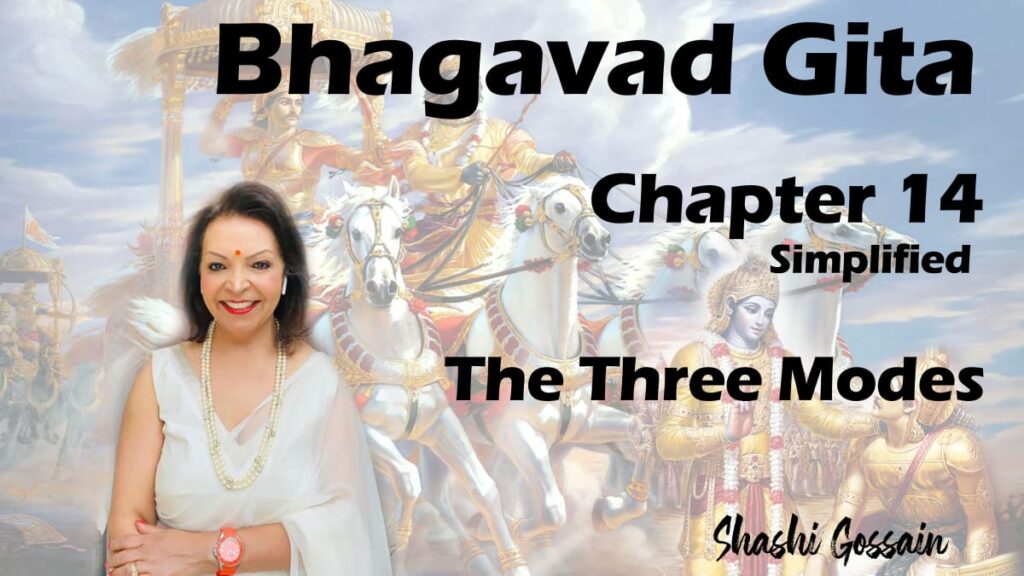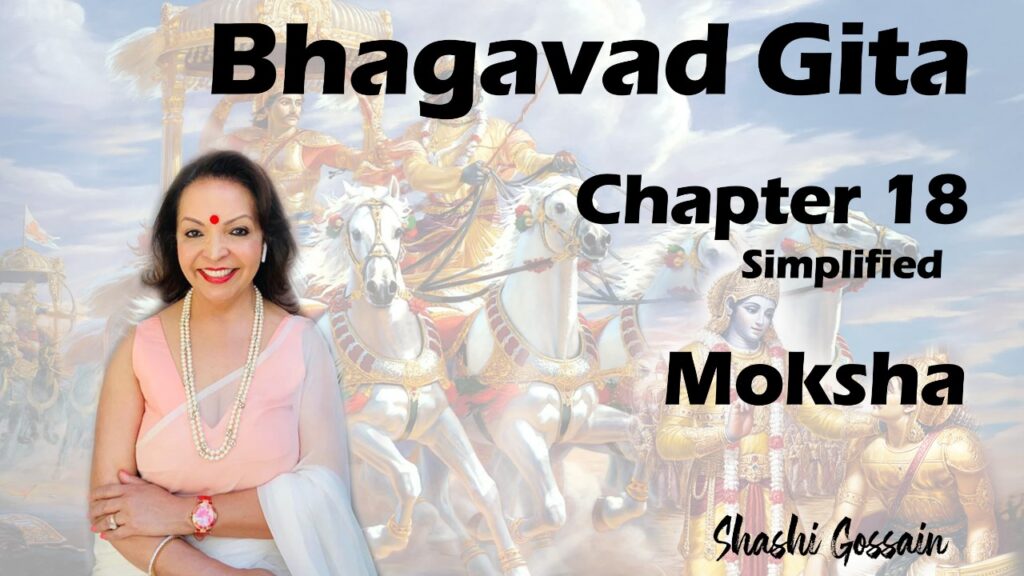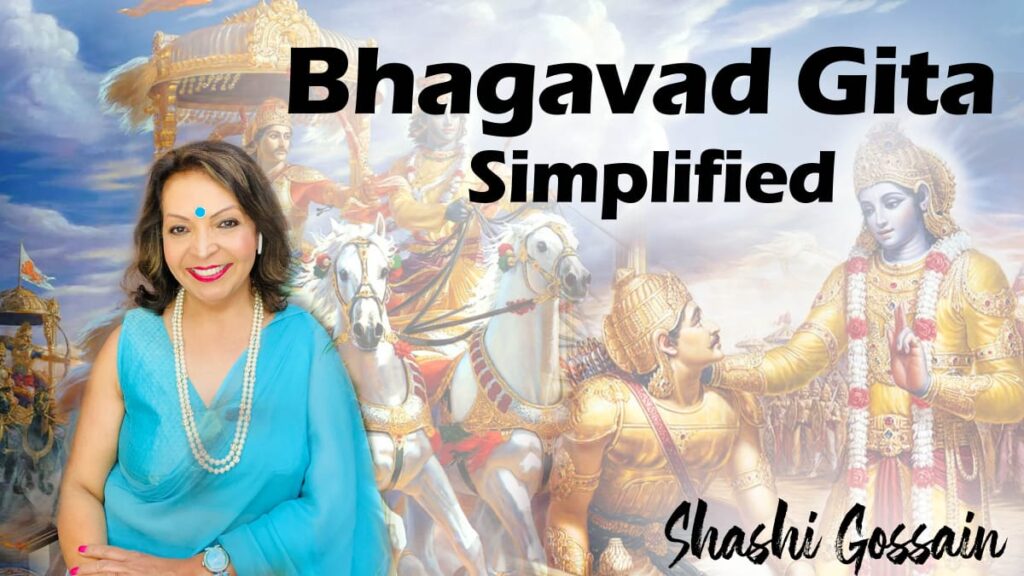In the thirteenth chapter, we learned that our existence in this world is the result of a two-step problem.
- Ignorance of our real nature.
The supreme self, which is our true nature, mistakenly identifies itself with one body within Prakriti and becomes the Purusha or jeeva. - The jeeva gets trapped as a result of its attachment to the three gunas of Prakriti.
Lord Shri Krishna said that it is the association with the guṇas of prakṛti that is responsible for rebirth i.e. saṃsāra
Shrimad Bhagvat Geeta- Chapter 14
In this chapter, the Lord Shri Krishna shows us how one can detach and be free from these binding guṇas.
What are the three modes of nature?
In Shrimad Bhagvat Geeta Shri Krishna says that there are three modes of nature:
- Goodness: illuminates, frees us from sinful actions, leading to happiness. One who dies in the mode of goodness attains the higher planets.
- Passion: plagued by unlimited desires for boundless material enjoyment. To satisfy those desires, he is always forced to engage in hard work that binds him to sinful reactions, resulting in misery. Hes never satisfied. After death. He again takes birth on earth amog persons engaged in frantic activity.
- Ignorance: means delusion. It fosters madness, indolence, laziness, and foolishness. When he dies, he has to take birth in the animal kingdom.
How do the three Gunas relate to the mind?
These modes (discussed above) compete in exerting their influence upon the conditioned soul. By observing the actions of these and learning to distinguish & detach, modes at work, we can attain Shri Krishna’s spiritual nature. In this chapter Shri Krishna repeats the glory of the self-knowledge. He systematically lists:
- The subject matter of the chapter: the knowledge of brahman
- The student one, who has a contemplative mind, is qualified to study this chapter.
- The goal of this chapter: liberation from sorrow
What do you mean by self realization?
If we have removed our ignorance through knowledge, if we have realized our true nature as identical to that of Ishvara, we will see things from Ishvara’s perspective and stop identifying with the ups and downs experienced by our body. When we know brahman as our own self, the goal is attained.
What does Prakriti mean? What is Kshetrajna?
Ishvara, at the beginning of creation, split himself into his two aspects:
-
Prakriti, the matter, which comprises of three gunas or qualities.
Prakriti has the power to generate an infinite variety of forms through innumerable permutations and combinations of its three gunas. But it is inert. It cannot create the universe by itself. - Kshetrajnya: The awareness aspect of Ishvara. This is needed to infuse Prakriti with life. This happens when Ishvara places all of the purushas into prakriti, just like seeds are placed into soil. This illusory link between the Purusha and Prakriti becomes the source of its birth and rebirth in the cycle of samsaara. Shri Krishna says that Ishvara, having divided himself into his two aspects, is both the mother and father of everything and every living being in the universe. The ultimate womb or source of the birth of all beings is the great brahman or Prakriti, which is nothing but the three gunas. We need to remove the impact and influence of the three gunas, which gives us sorrow, exert upon us.
What are the three Gunas in the Bhagavad Gita?
Components of Prakriti:
Shri Krishna divides Prakriti into its three components: the gunaas which are sattva, rajas and tamas, which in turn, affects the purusha, the individual soul. Prakriti binds the imperishable body dweller, the jeeva to the body. Guna is a state of mind, which makes us experience so many emotions.
- Tamas: inert matter
- Rajas: action
- Sattva: harmony
We can feel calmness, passion & lethargy according to the proportion of these components in our body at any given time. It’s our ignorance when we allow gunas to affect our moods.
Sattva (Satvik Gun)
Sattva refers to purity and brightness,
- We experience joy, peace and calmness
- We are alert, think very logically
- We feel healthy as we are close to our natural state of joy.
Shri Krishna reminds us that sattva too has the ability to bind and trap us, because we would like to remain in a state of joy and calmness. We mistake the joy provided by sattva because we have not experienced what real joy is. That can only happen in meditation when we are able to access the joy that is inherent in the “I”, in the self. All other joys are in the realm of Prakriti – temporary, perishable, and illusory. Rajas (Rajasi Gun) Rajas is our state of mind when it is agitated. It:
- Creates a thirst for what we do not possess, and
- Attachment towards what we already possess.
Rajas creates a vicious cycle. It fuels our desires, creates thoughts that compel us to act so that we can acquire objects, then it creates attachment to those objects which further increases rajas. Rajas binds the self through attachment to action and its results. It makes us say “I am the doer” and “I am the enjoyer” whereas it is actually Prakriti that is acting and providing the results. Karma yoga helps us come out of this bondage and entrapment. It teaches us to continue to act in this world, but do it in a way that removes our identification with Prakriti. We slowly start submitting the results of our actions to Ishvara, then we slowly start letting Ishvara take over the doership of our actions as well.
Tamas (Tamasik Gun)
Tamas is our state of mind when it is dull and inert. It prevents our mind from thinking clearly. Our mind starts to operate in confusion. A tamasic state can also be triggered by abusing our sense organs through excessive drinking, smoking or drugs. Our memory does not work properly and our intellect is diminished. Tamas is born out of ignorance. Tamas keeps the Purusha, the jeeva, body dweller under the delusion that he is the body and not the self. This ignorance enables tamas to bind us, to trap us. Tamas binds us in three ways, through:
- Performance of actions without intellectual focus e.g. gambling.
- Laziness; postponing or abstaining from our duties
- Lethargy; lying around in a state of stupor or sleep.
Some of us derive joy from futile actions, from lazing around etc. It is this joy through which tamas binds us.
How do the three Gunas work?
In the second chapter, Shri Krishna described how the mind can fall from sattva into rajas and tamas in a matter of seconds. We start with the mind resting in a peaceful sattvic state. A tinge of rajas comes in, causing us to think about some sense object, e.g. a sweet. This fuels rajas further, creating a strong attachment to that sweet, culminating in a strong desire to do anything to get that sweet. But it gets worse. If we cannot get that sweet, or if someone stops us eating the sweet, anger arises in us. Rajas deteriorates into tamas. Conversely, we can go from tamas to rajas to sattva, but it may take a little longer. For someone steeped in tamas, immersing themself in action will raise them to the level of rajas. When action becomes focused and directed towards the pursuit of a selfless goal, rajas is elevated to sattva. So, our mind is always under the influence of the three gunas. Shri Krishna says that our mind can only be under the impact of one gunaa at a time. This happens when one gunaa assumes dominance, and consequently, asserts its authority over the others. When sattva is dominant, it dominates over rajas and tamas. All three gunas are at constant war with each other in our mind. When one gunaa achieves victory, it temporarily defeats the others. We need to look within. We need to understand our thoughts, feelings and emotions & differentiate which gunaa is dominating at any one time.
What does sattvic mind look like?
Shri Krishna says that even though the sense organs are meant to receive stimuli from the world, they can also convey our internal state to the world. Our eyes can give away our thoughts. If mind is wondering, eyes will wonder. A sattvic person radiates calmness and peace. We can sense peace if we are near them. The light of their eternal essence shines through. Shri Krishna explained that whenever our mind generates thoughts of greed, selfish activity, unrest or uneasiness, and desire for even trivial things, we should realize that we are under the influence of rajas. When we are under the influence of tamas, we make wrong decisions. We become inert like a stone, resorting to inaction. Our knowledge is covered by tamas, creating darkness within us. Nature has its own scale of tamas, rajas and sattva. It is better to crawl like an insect than lie around like a stone. So if one has tamas quality, he should start to act, just to get into a higher mental state.
Effects of Guna:
Shri Krishna then explains the effects of each gunaa from the perspective of reincarnation.
A. Mental state
Our desires and thoughts, which are influenced by the gunaas, will determine our fate after this physical body perishes. The subtle body, which is nothing but our desires and thoughts, will attract another physical body that enables it to carry out those desires. It is almost similar to DNA shaping a body based on the programming it contains. Therefore, if our subtle body harbours sattvic thoughts, it will gain entry into a highly sattvic body after death.
- One, whose mind is in a sattvic state during the time of death, goes to “Brahmaloka”, the abode of Lord Brahma. There’s no desire, sorrow or disease.
- One, whose mental state is rajasic while dying, is reborn in a family of action oriented individuals.
- One, whose mental state is tamasic while dying, is reborn in the wombs of the ignorant and the inert. This includes plants, trees, creepers, birds, insects and other animals
It is not just the mental state that determines one’s fate in the next life.
B. Action
Every action we perform leaves impressions in our mind, which also impacts our fate. One who has performed?
- Selfless actions throughout their life are born in a virtuous family.
- Selfish actions are born with a tendency to get attached to material objects.
- Harmful actions are born with devilish tendencies. Such a person will not stop at anything to get their way, including physically harming others.
It is only through selfless service & devotion, that you can reduce the effect of the rajas or tamas.
Shri Krishna urges us to employ: - Rajas to perform selfless service, and cultivate
- Sattva through reducing selfish activities
If we are predominantly rajasic by nature, we can improve our state by emphasizing the performance of sattvic actions. e.g. taking up work to help the poor. If we are predominantly tamasic by nature, we can change it by emphasizing the performance of rajasic actions. e.g. for a lazy person, to make a habit of going to the gym. The law of karma states if we perform: - rajasic actions, we will attain temporary joy, which will eventually generate sorrow.
- tamasic actions, we will continue to live our lives in inertness and ignorance.
Only through sattvic actions will we create a state of purity and serenity in our mind.
Mental attitude
A sattvic attitude can access spiritual knowledge, since it can think clearly and grasp information quickly. A rajasic attitude makes us want even more objects than we already have. A tamasic attitude is the worst, as it is in ignorance. We perform futile or careless actions. By urging us to perform selfless actions, Shri Krishna wants us to rise from our rajasic and tamasic existence to one of greater sattva. The will to self-improve must come from within. Shri Krishna urges us to not get trapped in the machine called Prakriti, which is nothing but the three gunas. Because it leads to laws of karma, including birth, death, rebirth, joy, sorrow and so on. Once we recognize it as an illusion, and not as reality, and we can establish ourselves as a detached witness, and just perform the right actions. Shri Krishna now re-iterates the message. He says that Prakriti, made of the three gunaas, creates this entire universe, including our body. If the soul,(jeeva) or the body dweller becomes attached to the physical body, he will experience sorrows throughout his life. Once it stops identifying with the body, he attains liberation and becomes immortal. As we saw in the last chapter, ignorance of our true nature creates an entity called the Purusha, which is a bundle of unfulfilled desires in our mind. This attracted a combination of sattva, rajas and tamas that becomes the physical body. Only when the Purusha, sees the unreal play of the gunas & rises above it, & proceeds to cut the connection with this body, will he realize his true nature as the eternal essence. This ultimate freedom from the influence of the Prakriti is what makes him immortal. The modifications of the body such as old age and disease are as if they are happening to some third party. Having heard the explanation about the three gunas,
Arjun wanted to know three things.
- What are the characteristics of a person has transcended the three gunas?
- How does such a person behave in the world?
- How does he actually transcend the three gunas?
Shri Krishna answers Arjuna’s question:
“What are the marks of one who has transcended the gunas?”
The person, whose mind is stable in all situations and has detached himself from delusions of the gunas. One who has realised that all emotions and matter are just a combination of effects of sattva, rajas and tamas. Such a person has transcended the gunas. When we are able to treat our thoughts with the same detachment that we do when we are seeing a movie, we will know that we have gone beyond the gunas. Shri Krishna now addresses the second question.
“How does one who has gone beyond the gunas behave in this world?”
He says that such a person lives life with ease and grace. He remains calm and unperturbed even when facing their darkest personal challenges.
What makes a person so calm?
There are two factors.
- He has a great deal of detachment towards the world.
- He is seated on an unshakeable knowledge of self.
This is possible through the constant awareness that the entire world, including one’s own body, is a play of the three gunas. He has learnt to be an observer. He will view the whole world as the gunas interacting with the gunas. The “I” within him will be firmly seated in itself, with a healthy level of distance and detachment from the movement of those gunas. It will stop identifying, giving importance, giving reality to the play of gunas. The gunas will move, but the “I” within him will not. Such a person maintains a state of balance with people & objects of the world. In this shloka, krishnaji mentioned: a lump of clay, a stone, and a piece of gold. He will realise it’s the gunas that give him joy or sorrow looking at different objects and with this knowledge; he will maintain his balance and equanimity. Just like objects, different types of people can generate different reactions in different circumstances. Friends can become rivals; relatives can become enemies within minutes, which are all a play of gunas. One who has learned to transcend the gunas will remain the same in praise, insult, friend or foe. His “I”, his self, has nothing to do with any of these. One who has truly renounced all activities, given all up notions such as “I am”, who has gone beyond the three gunas. He realises that the world is nothing but the gunas interacting with the gunas. Through discrimination and detachment, we can see ourselves as distinct and separate from the gunas. He will be indifferent to what the world thinks of him. Honour and dishonour are the same to him. He treats friends and foes alike. Shri Krishna says that the answer is the yoga of unwavering devotion. We cannot keep Ishvara as our goal from 7 am to 8 am and then start thinking about how to cheat from 8 am to 11 am. The one and only goal should be Ishvara. Having maintained such awareness throughout our life, we become fit to attain brahman. In previous chapters, Krishnaji had explained that through the yoga of knowledge, one could get liberation or moksha. He showed us the technique of mentally removing the upaadhis, the barriers, to get to the eternal essence, in its purest form, called brahman, that is at the core all of us. Now Krishnaji also stated that liberation would be attained by the one who has undivided devotion towards Ishvara. Shri Krishna says that he, as Ishvara, is the abode of the pure eternal essence, of nirguna brahman. In other words, undivided devotion to Ishvara results in the same outcome as does the yoga of knowledge. He also describes this pure eternal essence as immortal, imperishable, eternal and full of joy. Furthermore, he says that the eternal essence is attained through the dharma or constitution of devotion and knowledge.




Pingback: Bhagavad Gita Chapter 15: The Self - Simple Hinduism